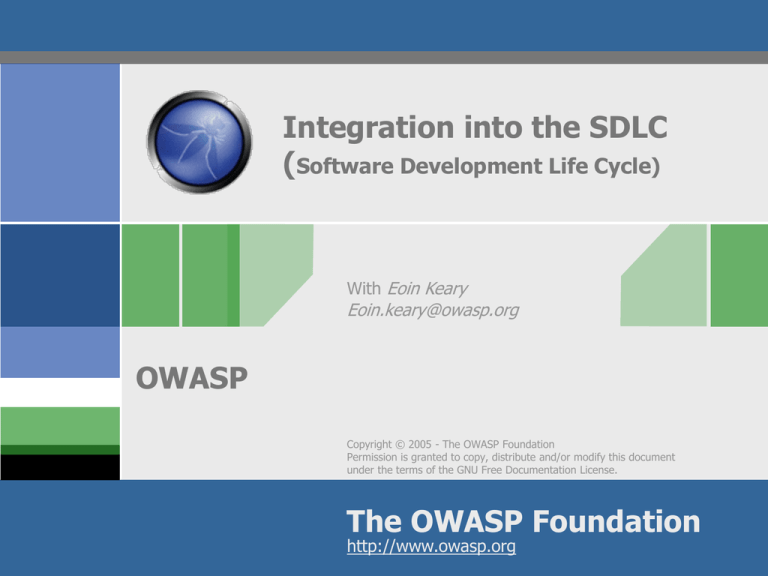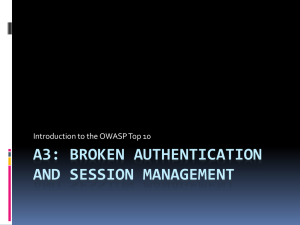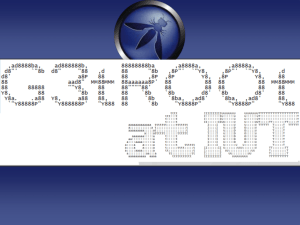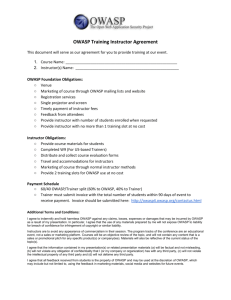Application Security Tools
advertisement

Integration into the SDLC (Software Development Life Cycle) With Eoin Keary Eoin.keary@owasp.org OWASP Copyright © 2005 - The OWASP Foundation Permission is granted to copy, distribute and/or modify this document under the terms of the GNU Free Documentation License. The OWASP Foundation http://www.owasp.org Bespoke Applications Vs. Commercial Applications Application Development internal use: • Bespoke, customized, one-off application •Audience is not so great: (Users, developers, test) Vulnerabilities are not discovered too quickly by users. Vulnerabilities are discovered by hackers, they actively look for them. Bespoke application = Small audience = Less chance of vulnerabilities being discovered This is unlike, Say Microsoft XP 210 Million copies sold (http://www.forbes.com/ May2004) First Line of Defense: The Developer: •Writes the code. •Understands the problem better than anyone! •Has the skill set. •More effective and efficient in providing a solution OWASP Complexity Vs Security As Functionality and hence complexity increase security decreases. Integrating security into functionality at design time Is easier and cheaper. “100 Times More Expensive to Fix Security Bug at Production Than Design” – IBM Systems Sciences Institute It also costs less in the long-term. -maintenance cost OWASP A Few Facts and figures: How Many Vulnerabilities Are Application Security Related? OWASP Growth of Threat: Growth in the tools available. 25,000 15,000 10,000 5,000 0 19 80 19 81 19 82 19 83 19 84 19 85 19 86 19 87 19 88 19 89 19 90 19 91 19 92 19 93 19 94 19 95 19 96 19 97 19 98 19 99 20 00 20 01 20 02 20 03 20 04 Hacker Tools 20,000 Categories: • Binder • Carding • Cracking Tool • Flooder • Key Generator • Mail Bomber • Mailer • Misc Tool • Nuker • Packer • Password Cracker • Password Cracking Word List • Phreaking Tool • Port Scanner • Probe Tool • Sniffer • Spoofer • Trojan • Trojan Creation Tool • Virus Creation Tool • Virus Source • Virus Tutorial • War Dialer Year Source: PestPatrol.com OWASP A Few Facts and figures (contd) Interesting Statistics – Employing code review IBM Reduces 82% of Defects Before Testing Starts HP Found 80% of Defects Found Were Not Likely To Be Caught in Testing 100 Times More Expensive to Fix Security Bug at Production Than Design” – IBM Systems Sciences Institute Promoting People Looking at Code Improvement Earlier in SDLC Fix at Right Place; the Source Takes 20% extra time – payoff is order of magnitude more. Ref: http://ganssle.com/Inspections.pdf OWASP If cars Were Built Like Applications…. 1. 2. 3. 4. 5. 6. 7. 8. 9. 10. 11. 12. 70% of all cars would be built without following the original designs and blueprints. The other 30% would not have designs. Car design would assume that safety is a function of road design and that all drivers were considerate, sober and expert drivers. Cars would have no airbags, mirrors, seat belts, doors, roll-bars, side-impact bars, or locks, because no-one had asked for them. But they would all have at least six cup holders. Not all the components would be bolted together securely and many of them would not be built to tolerate even the slightest abuse. Safety tests would assume frontal impact only. Cars would not be roll tested, or tested for stability in emergency maneuvers, brake effectiveness, side impact and resistance to theft. Many safety features originally included might be removed before the car was completed, because they might adversely impact performance. 70% of all cars would be subject to monthly recalls to add major components left out of the initial production. The other 30% wouldn’t be recalled, because no-one would sue anyway. The after-market for safety devices would include such useful products as training wheels, screen doors, elastic seatbelts and devices that would restrict the car’s top speed to 3mph, if found to be unsafe (which would be always). Useful safety could be found, but could only be custom retro-fitted, would take six months to fit and would cost more than the car itself. A NCT/MOT inspection would consist of counting the wheels and making recommendations on wheel quantity. Your only warning indicator would be large quantities of smoke and flame in the cab. You could only get insurance from one provider, it would be extremely expensive, require a duplicate NCT/MOT inspection, and you might still never be able to claim against the policy. - Denis Verdon OWASP How do we do it? Security Analyst: Get involved early in SDLC. Security is a function of the asset we want to secure, what's it worth? Understanding the information held in the application and the types of users is half the battle. Involve an analyst in the design phase and thereafter. Developer: Embrace secure application development. (Educate) Quality is not just “Does it work” Security is a measure of quality also. OWASP How do we do it? (contd) QA: Security vulnerabilities are to be considered bugs, the same way as a functional bug, and tracked in the same manner. Managers: Factor some time into the project plan for security. Consider security as added value in an application. – $1 spent up front saves $10 during development and $100 after release OWASP Software security tollgates in the SDLC Iterative approach Security requirements Design Review Risk analysis Requirements and use cases Design Risk-based security tests Test plans Code Review Static analysis (tools) Code Penetration testing Test results Field feedback OWASP Application Security Risk Categorization Goal More security for riskier applications Ensures that you work the most critical issues first Scales to hundreds or thousands of applications Tools and Methodology Security profiling tools can gather facts Size, complexity, security mechanisms, dangerous calls Questionnaire to gather risk information Asset value, available functions, users, environment, threats Risk-based approach Evaluates likelihood and consequences of successful OWASP attack Application Security Project Plan Define the plan to ensure security at the end Ideally done at start of project Can also be started before or after development is complete Based on the risk category Identify activities at each phase Necessary people and expertise required Who has responsibility for risks Ensure time and budget for security activities Establish framework for establishing the “line of sight” OWASP Application Security Requirements Tailoring Get the security requirements and policy right Start with a generic set of security requirements Must include all security mechanisms Must address all common vulnerabilities Can be use (or misuse) cases Should address all driving requirements (regulation, standards, best practices, etc.) Tailoring examples… Specify how authentication will work Detail the access control matrix (roles, assets, functions, permissions) Define the input validation rules Choose an error handling and logging approach OWASP Design Reviews Better to find flaws early Security design reviews Check to ensure design meets requirements Also check to make sure you didn’t miss a requirement Assemble a team Experts in the technology Security-minded team members Do a high-level penetration test against the design Be sure to do root cause analysis on any flaws identified OWASP Software Vulnerability Analysis Find flaws in the code early Many different techniques Static (against source or compiled code) Security focused static analysis tools Peer review process Formal security code review Dynamic (against running code) Scanning Penetration testing Goal Ensure completeness (across all vulnerability areas) Ensure accuracy (minimize false alarms) OWASP Application Security Testing Identify security flaws during testing Develop security test cases Based on requirements Be sure to include “negative” tests Test all security mechanisms and common vulnerabilities Flaws feed into defect tracking and root cause analysis OWASP Application Security Defect Tracking and Metrics “Every security flaw is a process problem” Tracking security defects Find the source of the problem Bad or missed requirement, design flaw, poor implementation, etc… ISSUE: can you track security defects the same way as other defects Metrics What lifecycle stage are most flaws originating in? What security mechanisms are we having trouble implementing? What security vulnerabilities are we having trouble avoiding? OWASP Configuration Management and Deployment Ensure the application configuration is secure Security is increasingly “data-driven” XML files, property files, scripts, databases, directories How do you control and audit this data? Design configuration data for audit Put all configuration data in CM Audit configuration data regularly Don’t allow configuration changes in the field OWASP What now? "So now, when we face a choice between adding features and resolving security issues, we need to choose security." -Bill Gates The user's going to pick dancing pigs over security every time. -Bruce Schneier If you think technology can solve your security problems, then you don't understand the problems and you don't understand the technology. -Bruce Schneier Using encryption on the Internet is the equivalent of arranging an armored car to deliver credit-card information from someone living in a cardboard box to someone living on a park bench. -Gene Spafford OWASP







